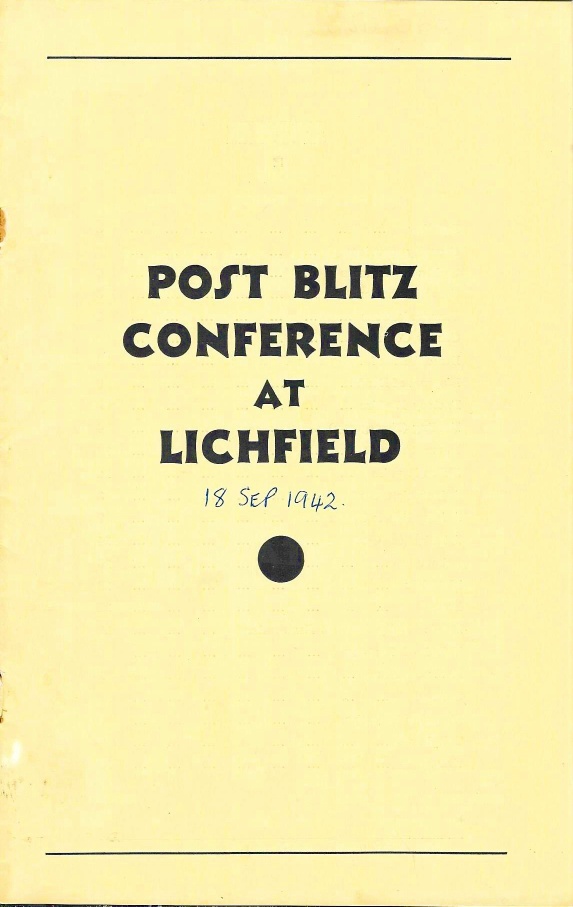On Friday the 18th of September 1942 an important, and no doubt at the time secret, conference was held in the Guildhall at Lichfield to discuss the city's preparedness in the event of a major air raid by the German Luftwaffe.
Although bombing raids continued throughout the war, the blitz on London and other major industrial cities and ports had mainly been between the Autumn of 1940 and the end of 1941. R.A.F. Lichfield was at nearby Fradley but the City had no industries of military significance that would make it a likely target. Indeed, the Bombing Britain dataset of over 32,000 air raids contains only three entries for Lichfield, between 17th August and 19th October 1940, with no recorded casualties.
So, why might such a conference have been considered necessary in Lichfield as late as September 1942? The answer may lie in the so-called Baedeker raids.
Following Allied air attacks on the historic German cities of Lübeck and Rostock, a German propagandist claimed that Hitler had vowed to destroy British cities that had been awarded the maximum three stars in the pre-war Baedeker travel guides. In April and May of 1942, severe damage was inflicted on Bath, Canterbury, Exeter, Norwich and York.
Perhaps the great and good of Lichfield felt that its history, architecture and cultural associations might merit similar attention from the Luftwaffe heavy bombers. If so, they were to be disappointed; although there were later raids on primarily cultural targets - for example, Cheltenham was attacked in 1943.
The conference was chaired by Councillor W.F.L. Salloway, Sheriff and Chairman of the Civil Defence Committee. At least three dozen people were present; including the Mayor and other members of the City Council, the Town Clerk, representatives from a wide range of Government Ministries and the military and civilian uniformed services, together with other local officials.
A detailed record of the proceedings was recorded in a 16-page booklet, amounting almost to a transcript of who said what. This was printed by the Lichfield Mercury. Was it ever made available to the public? At the time it would surely only have been distributed to those with a need to know.
The contents of the booklet show that every aspect of response and recovery after a major air raid was discussed: billeting; casualty services; claims for injuries; coal distribution; County control; demolition of dangerous buildings; disposal of the dead; feeding; factory repairs; Home Guard; house repairs; information centre; information to the public; intelligence centre; labour; materials; police; public utility services restoration; relief of distress; rest centres; salvage; shopping facilities; telephones and transport.
Examples from the section on restoration of public utilities give a flavour of the detailed information contained in the booklet. If the Lichfield exchange had been completely put out of action telephone, communication with the outside world would still have been possible. A wire had been strung from the south to the Three Tuns Hotel on Walsall Road. Officials with a key could insert this and press a button on a specially installed telephone, to be connected direct to the Birmingham trunk exchange. A similar arrangement was being installed at the Shoulder of Mutton public house on London Road (now The Owl at Lichfield), from where a wire was to be run to Burton-on-Trent. In addition, the London, Midland and Scottish Railway would have allowed the Civil Defence Organisation to use their private telephone lines to Burton, Tamworth and Birmingham; and the police would have given them access to their separate telephone system.
The Water Engineer for the Conduit Lands explained that it drew supplies for the city from two of the South Staffordshire Waterworks Company's mains. These were inter-connected, allowing for redistribution around the system if one was put out of use. A third, much smaller, connection at the junction of Valley Lane and Trent Valley Road could be opened, but the water from that would only reach as far as Greenhill. Although disused, the reservoir off Beacon Street and the old main from Aldershaw were both being maintained and could be reactivated to provide a limited supply. However, a proposal to draw an emergency supply from the well of the Lichfield Brewery Company in St. John Street had been vetoed by the Ministry of Health.

Photo - William Henwood, 2022
Employees of the Lichfield Gas Company had gone to Coventry to provide assistance there after the devastating raid in November 1940 and had gained much valuable knowledge. They had built up a stock of key components and equipment so that, if the gas works was still functioning, rapid repairs to mains and restoration of supply should be possible.
Among the many other contingency plans described, one learns that fifteen Rest Centres for displaced people had been earmarked in the City, providing places for up to 575 'sleeping' and 3,370 'sitting' people. Six of these, accommodating 420 people, would be run by the Women's Voluntary Service. The destruction of large and irreparably damaged buildings would be entrusted to the manager of the Shenstone Brickworks company and a Mr. Kidd of Alrewas, both of whom were licensed to handle explosives. Up to 50 casualties would be buried in a mass grave at Christ Church, Leomansley, to be dug using a mechanical excavator, and another plot had been earmarked in St. Michael's Churchyard.
The consensus among the participants was that Lichfield was about as well prepared as it could be; many lessons having been learned in the aftermath of, and from responses to, major air raids elsewhere.
The conference concluded in a quintessentially English way when the Regional Post Blitz Officer, Mr. L. d'O. Tollemache, thanked the Chairman for so kindly providing tea for all those present.
William Henwood
June 2020